Are There Differences in Thermal Comfort Perception of Children in Comparison to Their Caregivers’ Judgments? A Study on the Playgrounds of Parks in China’s Hot Summer and Cold Winter Region
Abstract
:1. Introduction
2. Methods
2.1. Study Sites
2.2. Experimental Design
2.2.1. Survey Time
2.2.2. Meteorological Measurement
2.2.3. Questionnaire Design
- Ensure that the caregiver answering the questions is the primary caregiver in the child’s daily life and knows the child well;
- Participating children and their caregivers need to be in the same place and no more than 20 m away from the environmental testing instrument [31];
- The caregiver should answer independently, and then the volunteer and caregiver should work together to help the child understand the questions and complete the answers.
2.3. Thermal Index
2.4. Clothing Insulation and Metabolic Rate
2.5. Data Analysis and Statistics
3. Results
3.1. Descriptive Analysis
3.1.1. Physiological Characteristics
3.1.2. Meteorological Parameters
3.1.3. TSV
3.1.4. Meteorological Variables and TSV
3.2. Outdoor Thermal Benchmark and Environmental Assessment
3.2.1. Neutral PET (NPET)
3.2.2. Neutral PET Range (NPETR)
3.2.3. PET Calibrations
3.2.4. Thermal Calendars
3.3. Climate Adaptation Preferences and Design Strategies
3.3.1. Meteorological Parameter Preference Vote
3.3.2. Thermal Adaptive Behaviors
3.3.3. Application of “Research for Design”
4. Discussion
4.1. Children-Caregiver Differences
- There are differences in morphology, metabolism, cardiovascular and sweating rates between children and adults, which will lead to caregivers evaluating the child’s thermal comfort differently from the child’s results [48,49,50]. In addition, children have limited cognition and their behaviors and personal responses are less influenced by social experiences and traditional rules than adults, which leads children to be less sensitive than adults to changes in meteorological factors and to show differences in adaptive behavioral choices when conducting thermal environment evaluations [51,52].
- These differences may be affected by the different activities of preschool children and their caregivers on the playground. When preschool children are engaged in outdoor activities, they focus on the game and are attracted by the natural and artificial elements of the site. Compared to changes in meteorological factors, they are more concerned with the playfulness of the site. However, for caregivers, their primary task on playgrounds is to care for their children and prevent them from being harmed, so change in meteorological factors is one of the key elements that caregivers pay attention to. Due to the different concerns of children and their caregivers on the playground, there may be differences in their sensitivity to environmental changes and climate adaptation preferences.
4.2. Thermal Benchmarks
4.2.1. NPET
4.2.2. NPETR
4.3. Limitations
5. Conclusions
- TSVpc and TSVcg had the highest proportion of “neutral” in both winter and summer seasons. The proportion of “neutral” in winter is higher than in summer, and no respondents chose “very cold” in winter, which reflects that playgrounds offer better thermal comfort in winter.
- The correlation between TSVpc and meteorological factors was weaker than that of TSVcg, indicating that children are less sensitive to changes in meteorological factors than adults.
- The NPET of preschool children is 22.9 °C in summer and 10.6 °C in winter, while that of caregivers is 22.3 °C in summer and 11.0 °C in winter. The NPETR of preschool children is 15.7–30.2 °C in summer and 0.3–21 °C in winter, while that of caregivers is 15.4–29.3 °C in summer and 1.6–20.5 °C in winter.
- To improve thermal comfort, preschool children and caregivers want lower temperatures in the summer and more solar radiation in the winter. They also expect to be “cooler” in the summer than “warmer” in the winter. Although both preschool children and caregivers showed a preference for summer shade and winter sunlight in their adaptive behavioral choices, there were differences between their preferences. Significantly more preschool children (52.5%) than caregivers (23.7%) chose “cold drinks” in summer, and more children than caregivers chose additional clothing and hat-gloves in winter.
- Based on the evaluation of preschool children and caregivers, the improvement of summer comfort is important to increase the usage of playgrounds. The comfort level of the sites can be improved by planting deciduous trees and adding water play and service facilities.
Author Contributions
Funding
Institutional Review Board Statement
Informed Consent Statement
Data Availability Statement
Acknowledgments
Conflicts of Interest
Appendix A
| Summer | Winter | |||
|---|---|---|---|---|
| Garment | clo | Garment | clo | |
| Tops | Sleeveless vest | 0.06 | Long underwear top | 0.2 |
| T-shirt, short sleeves | 0.08 | Flannel long underwear | 0.3 | |
| T-shirt, long sleeves | 0.2 | Thin sweater | 0.25 | |
| Summer jacket | 0.3 | Thick sweater | 0.36 | |
| Thick coat | 0.4 | |||
| Down jacket | 0.55 | |||
| Parka | 0.7 | |||
| Bottoms | Short shorts | 0.06 | Long underwear bottoms | 0.15 |
| Trousers | 0.20 | Trousers | 0.20 | |
| Summer skirt | 0.14 | Flannel trousers | 0.28 | |
| Winter skirt | 0.23 | |||
| Upper and lower one-piece clothes | Summer dress, short sleeves | 0.29 | Winter dress, long sleeves | 0.47 |
| Summer dress, long sleeves | 0.33 | |||
| Sundries | Thin ankle socks | 0.02 | Thick ankle socks | 0.05 |
| Sandals | 0.02 | Thick long socks | 0.10 | |
| Thin sneakers | 0.02 | Thick sneakers | 0.04 | |
| Hat | 0.01 | Boots | 0.10 | |
| Hat | 0.01 | |||
| Scarf | 0.08 | |||
| Gloves | 0.05 | |||
| Preschool Children’s Activities | Reference Activities | MET Units |
|---|---|---|
| Resting, sitting | Resting | 1.0 |
| Swing, rocking on a chair | Filing, sitting | 1.2 |
| Playing with sands and walking | Walking and lifting/packing | 1.9 |
| Climbing and sliding | Climbing ladder and sitting and walking | 3.4 |
| High-speed running, riding, and skateboarding | Moving at 1.8 m/s, 6.8 km/h | 3.9 |
References
- Bento, G.; Dias, G. The importance of outdoor play for young children’s healthy development. Porto Biomed. J. 2017, 2, 157–160. [Google Scholar] [CrossRef]
- Jutras, S. Go outside and play! Contributions of an urban environment to the developing and wellbeing of children. Can. Psychol. Psychol. Can. 2003, 44, 257–266. [Google Scholar] [CrossRef]
- Oakley, J.; Peters, R.L.; Wake, M.; Grobler, A.C.; Kerr, J.A.; Lycett, K.; Cassim, R.; Russell, M.; Sun, C.; Tang, M.L.K.; et al. Backyard benefits? A cross-sectional study of yard size and greenness and children’s physical activity and outdoor play. BMC Public Health 2021, 21, 1402. [Google Scholar] [CrossRef] [PubMed]
- McCurdy, L.E.; Winterbottom, K.E.; Mehta, S.S.; Roberts, J.R. Using nature and outdoor activity to improve children’s health. Curr. Problem Pediatr. Adoles. Health Care. 2010, 40, 102–117. [Google Scholar] [CrossRef] [PubMed]
- Flouri, E.; Midouhas, E.; Joshi, H. The role of urban neighbourhood green space in children’s emotional and behavioural resilience. J. Environ. Psychol. 2014, 40, 179–186. [Google Scholar] [CrossRef]
- Vella-Brodrick, D.A.; Gilowska, K. Effects of Nature (Greenspace) on Cognitive Functioning in School Children and Adolescents: A Systematic Review. Educ. Psychol. Rev. 2022, 1–38. [Google Scholar] [CrossRef]
- Sherbakov, T.; Malig, B.; Guirguis, K.; Gershunov, A.; Basu, R. Ambient temperature and added heat wave effects on hospitalizations in California from 1999 to 2009. Environ. Res. 2018, 160, 83–90. [Google Scholar] [CrossRef]
- Grundstein, A.J.; Scarneo-Miller, S.E.; Adams, W.M.; Casa, D.J. From theory to practice: Operationalizing a climate vulnerability for sport organizations framework for heat hazards among US High schools. J. Sci. Med. Sport 2020, 24, 718–722. [Google Scholar] [CrossRef]
- Akerlof, K.; Debono, R.; Berry, P.; Leiserowitz, A.; Roser-Renouf, C.; Clarke, K.-L.; Rogaeva, A.; Nisbet, M.C.; Weathers, M.R.; Maibach, E.W. Public Perceptions of Climate Change as a Human Health Risk: Surveys of the United States, Canada and Malta. Int. J. Environ. Res. Public Health 2010, 7, 2559–2606. [Google Scholar] [CrossRef]
- Tremblay, M.S.; Gray, C.; Babcock, S.; Barnes, J.; Bradstreet, C.C.; Carr, D.; Chabot, G.; Choquette, L.; Chorney, D.; Collyer, C.; et al. Position Statement on Active Outdoor Play. Int. J. Environ. Res. Public Health 2015, 12, 6475–6505. [Google Scholar] [CrossRef] [Green Version]
- Tremblay, M.S.; Barnes, J.D.; González, S.A.; Katzmarzyk, P.T.; Onywera, V.O.; Reilly, J.J.; Tomkinson, G.R. Global matrix 2.0: Report card grades on the physical activity of children and youth comparing 38 countries. J. Phys. Act. Health 2016, 13, S343–S366. [Google Scholar] [CrossRef] [PubMed]
- Antoniadis, D.; Katsoulas, N.; Papanastasiou, D. Thermal Environment of Urban Schoolyards: Current and Future Design with Respect to Children’s Thermal Comfort. Atmosphere 2020, 11, 1144. [Google Scholar] [CrossRef]
- ISO 7730; Ergonomics of the Thermal Environment—Analytical Determination and Interpretation of Thermal Comfort using Calcu-lation of the PMV and PPD Indices and Local Thermal Comfort. International Standardization Organization: Geneva, Switzerland, 2005.
- ANSI/ASHRAE Standard 55-2020; Thermal Environmental Conditions for Human Occupancy. ASHRAE: Atlanta, GA, USA, 2020.
- ISO 8996; Ergonomics of the Thermal Environment—Determination of Metabolic Rate. International Standardization Organization: Geneva, Switzerland, 2021.
- ISO 7243; Ergonomics of the Thermal Environment—Assessment of Heat Stress using the WBGT (Wet Bulb Globe Temperature) Index. International Standardization Organization: Geneva, Switzerland, 2017.
- Haddad, S.; Osmond, P.; King, S. Revisiting thermal comfort models in Iranian classrooms during the warm season. Build Res. Inform. 2017, 45, 457–473. [Google Scholar] [CrossRef]
- Aparicio-Ruiz, P.; Barbadilla-Martín, E.; Guadix, J.; Muñuzuri, J. A field study on adaptive thermal comfort in Spanish primary classrooms during summer season. Build. Environ. 2021, 203, 108089. [Google Scholar] [CrossRef]
- Teli, D.; Jentsch, M.F.; James, P.A.B. Naturally ventilated classrooms: An assessment of existing comfort models for predicting the thermal sensation and preference of primary school children. Energy Build. 2012, 53, 166–182. [Google Scholar] [CrossRef]
- Vanos, J.K.; Herdt, A.J.; Lochbaum, M.R. Effects of physical activity and shade on the heat balance and thermal perceptions of children in a playground microclimate. Build. Environ. 2017, 126, 119–131. [Google Scholar] [CrossRef]
- Huang, B.; Hong, B.; Tian, Y.; Yuan, T.; Su, M. Outdoor thermal benchmarks and thermal safety for children: A study in China’s cold region. Sci. Total Environ. 2021, 787, 147603. [Google Scholar] [CrossRef]
- Liu, Z.; Jim, C. Playing on natural or artificial turf sports field? Assessing heat stress of children, young athletes, and adults in Hong Kong. Sustain. Cities Soc. 2021, 75, 103271. [Google Scholar] [CrossRef]
- Peel, M.C.; Finlayson, B.L.; McMahon, T.A. Updated world map of the Köppen-Geiger climate classification. Hydrol. Earth Syst. Sci. 2007, 11, 1633–1644. [Google Scholar] [CrossRef]
- Wuhan Local Chronicles Digital Local Chronicles Museum. Wuhan Chronicle—Volume 1 General Category Urban Construction. Available online: http://szfzg.wuhan.gov.cn/book/dfz/bookread/id/249/category_id/49630.html (accessed on 12 July 2021).
- Li, K.; Li, X.; Yao, K. Outdoor Thermal Environments of Main Types of Urban Areas during Summer: A Field Study in Wuhan, China. Sustainability 2022, 14, 952. [Google Scholar] [CrossRef]
- Nasrollahi, N.; Ghosouri, A.; Khodakarami, J.; Taleghani, M. Heat-Mitigation Strategies to Improve Pedestrian Thermal Comfort in Urban Environments: A Review. Sustainability 2020, 12, 10000. [Google Scholar] [CrossRef]
- Oliveira, A.V.M.; Raimundo, A.M.; Gaspar, A.R.; Quintela, D.A. Globe Temperature and Its Measurement: Requirements and Limitations. Ann. Work Expo. Health 2019, 63, 743–758. [Google Scholar] [CrossRef] [PubMed]
- Matzarakis, A.; Rutz, F.; Mayer, H. Modelling radiation fluxes in simple and complex environments—Application of the RayMan model. Int. J. Biometeorol. 2007, 51, 323–334. [Google Scholar] [CrossRef]
- Mi, J.; Hong, B.; Zhang, T.; Huang, B.; Niu, J. Outdoor thermal benchmarks and their application to climate—responsive designs of residential open spaces in a cold region of China. Build. Environ. 2019, 169, 106592. [Google Scholar] [CrossRef]
- Nikolopoulou, M.; Steemers, K. Thermal comfort and psychological adaptation as a guide for designing urban spaces. Energy Build. 2003, 35, 95–101. [Google Scholar] [CrossRef]
- Sun, C.-Y. A street thermal environment study in summer by the mobile transect technique. Arch. Meteorol. Geophys. Bioclimatol. Ser. B 2011, 106, 433–442. [Google Scholar] [CrossRef]
- Oliveira, S.; Andrade, H. An initial assessment of the bioclimatic comfort in an outdoor public space in Lisbon. Int. J. Biometeorol. 2007, 52, 69–84. [Google Scholar] [CrossRef]
- Kántor, N.; Unger, J. Benefits and opportunities of adopting GIS in thermal comfort studies in resting places: An urban park as an example. Landsc. Urban Plan. 2010, 98, 36–46. [Google Scholar] [CrossRef]
- Kántor, N.; Kovács, A.; Takács, Á. Seasonal differences in the subjective assessment of outdoor thermal conditions and the impact of analysis techniques on the obtained results. Int. J. Biometeorol. 2016, 60, 1615–1635. [Google Scholar] [CrossRef]
- Cheung, P.K.; Jim, C. Improved assessment of outdoor thermal comfort: 1-hour acceptable temperature range. Build. Environ. 2019, 151, 303–317. [Google Scholar] [CrossRef]
- Höppe, P. Die Wärmebilanzmodelle MEMI und IMEM zur Bewertung der thermischen Beanspruchung am Arbeitsplatz. Verh Dtsch Ges Arb. Umw. 1994, 34, 153–158. [Google Scholar]
- Baruti, M.M.; Johansson, E.; Yahia, M.W. Urbanites’ outdoor thermal comfort in the informal urban fabric of warm-humid Dar es Salaam, Tanzania. Sustain. Cities Soc. 2020, 62, 102380. [Google Scholar] [CrossRef]
- Makvandi, M.; Zhou, X.; Li, C.; Deng, Q. A Field Investigation on Adaptive Thermal Comfort in an Urban Environment Considering Individuals’ Psychological and Physiological Behaviors in a Cold-Winter of Wuhan. Sustainability 2021, 13, 678. [Google Scholar] [CrossRef]
- Matzarakis, A.; Rutz, F.; Mayer, H. Modelling radiation fluxes in simple and complex environments: Basics of the RayMan model. Int. J. Biometeorol. 2010, 54, 131–139. [Google Scholar] [CrossRef] [PubMed]
- Havenith, G. Metabolic rate and clothing insulation data of children and adolescents during various school activities. Ergonomics 2007, 50, 1689–1701. [Google Scholar] [CrossRef]
- Ainsworth, B.E.; Haskell, W.L.; Leon, A.S.; Jacobs, D.R., Jr.; Montoye, H.J.; Sallis, J.F.; Paffenbarger Jr, R.S. Compendium of physical activities: Classification of energy costs of human physical activities. Med. Sci. Sport Exerc. 1993, 25, 71–80. [Google Scholar] [CrossRef]
- Ainsworth, B.E.; Haskell, W.L.; Whitt, M.C.; Irwin, M.L.; Swartz, A.M.; Strath, S.J.; O’Brien, W.L.; Bassett, D.R., Jr.; Schmitz, K.H.; Emplaincourt, P.O.; et al. Compendium of Physical Activities: An update of activity codes and MET intensities. Med. Sci. Sports Exerc. 2000, 32, S498–S516. [Google Scholar] [CrossRef]
- National Health Commission of the People’s Republic of China. Notice of the Department of Women’s and Social Security of the Ministry of Health on Printing and Distributing the “Reference Standards for the Growth and Development of Children Under 7 Years of Age in China”. Available online: http://www.nhc.gov.cn/wjw/gfxwj/201304/b64543eaaee1463992e8ce97441c59bb.shtml (accessed on 12 July 2021).
- Haycock, G.B.; Schwartz, G.J.; Wisotsky, D.H. Geometric method for measuring body surface area: A height-weight formula validated in infants, children, and adults. J. Pediatr. 1978, 93, 62–66. [Google Scholar] [CrossRef]
- Schofield, W.N. Predicting basal metabolic rate, new standards and review of previous work. Hum. Nutr. Clin. Nutr. 1985, 39 (Suppl. S1), 5–41. [Google Scholar]
- Chen, W.; Deng, Y.; Cao, B. An experimental study on the difference in thermal comfort perception between preschool children and their parents. J. Build. Eng. 2022, 56, 104723. [Google Scholar] [CrossRef]
- Li, K.; Xia, T.; Li, W. Evaluation of Subjective Feelings of Outdoor Thermal Comfort in Residential Areas: A Case Study of Wuhan. Buildings 2021, 11, 389. [Google Scholar] [CrossRef]
- Falk, B.; Dotan, R. Children’s thermoregulation during exercise in the heat—a revisit. Appl. Physiol. Nutrit. Metab. 2008, 33, 420–427. [Google Scholar] [CrossRef] [PubMed]
- Smith, C.J. Pediatric Thermoregulation: Considerations in the Face of Global Climate Change. Nutrients 2019, 11, 2010. [Google Scholar] [CrossRef] [PubMed]
- Notley, S.R.; Akerman, A.P.; Meade, R.D.; Mcgarr, G.W.; Kenny, G.P. Exercise Thermoregulation in Prepubertal Children: A Brief Methodological Review. Med. Sci. Sports Exerc. 2020, 52, 2412–2422. [Google Scholar] [CrossRef]
- Ciucci, E.; Calussi, P.; Menesini, E.; Mattei, A.; Petralli, M.; Orlandini, S. Seasonal variation, weather and behavior in day-care children: A multilevel approach. Int. J. Biometeorol. 2012, 57, 845–856. [Google Scholar] [CrossRef]
- Vanos, J.K. Children’s health and vulnerability in outdoor microclimates: A comprehensive review. Environ. Int. 2015, 76, 1–15. [Google Scholar] [CrossRef]
- Leites, G.T.; Cunha, G.S.; Obeid, J.; Wilk, B.; Meyer, F.; Timmons, B.W. Thermoregulation in boys and men exercising at the same heat production per unit body mass. Eur. J. Appl. Physiol. 2016, 116, 1411–1419. [Google Scholar] [CrossRef]
- Liu, W.; Zhang, Y.; Deng, Q. The effects of urban microclimate on outdoor thermal sensation and neutral temperature in hot-summer and cold-winter climate. Energy Build. 2016, 128, 190–197. [Google Scholar] [CrossRef]
- Zeng, Y.; Dong, L. Thermal human biometeorological conditions and subjective thermal sensation in pedestrian streets in Chengdu, China. Int. J. Biometeorol. 2014, 59, 99–108. [Google Scholar] [CrossRef]
- Niu, J.; Hong, B.; Geng, Y.; Mi, J.; He, J. Summertime physiological and thermal responses among activity levels in campus outdoor spaces in a humid subtropical city. Sci. Total Environ. 2020, 728, 138757. [Google Scholar] [CrossRef]
- Li, K.; Zhang, Y.; Zhao, L. Outdoor thermal comfort and activities in the urban residential community in a humid subtropical area of China. Energy Build. 2016, 133, 498–511. [Google Scholar] [CrossRef]
- Yang, W.; Wong, N.H.; Zhang, G. A comparative analysis of human thermal conditions in outdoor urban spaces in the summer season in Singapore and Changsha, China. Int. J. Biometeorol. 2012, 57, 895–907. [Google Scholar] [CrossRef] [PubMed]
- Chen, Q.; Lin, C.; Guo, D.; Hou, Y.; Lai, D. Studies of outdoor thermal comfort in northern China. Build. Environ. 2014, 77, 110–118. [Google Scholar] [CrossRef]
- Alfano, F.D.; Ficco, G.; Frattolillo, A.; Palella, B.; Riccio, G. Mean Radiant Temperature Measurements through Small Black Globes under Forced Convection Conditions. Atmosphere 2021, 12, 621. [Google Scholar] [CrossRef]
- Lau, K.K.-L.; Choi, C.Y. The influence of perceived aesthetic and acoustic quality on outdoor thermal comfort in urban environment. Build. Environ. 2021, 206, 108333. [Google Scholar] [CrossRef]
- Khalili, S.; Fayaz, R.; Zolfaghari, S.A. Analyzing outdoor thermal comfort conditions in a university campus in hot-arid climate: A case study in Birjand, Iran. Urban Clim. 2022, 43, 101128. [Google Scholar] [CrossRef]
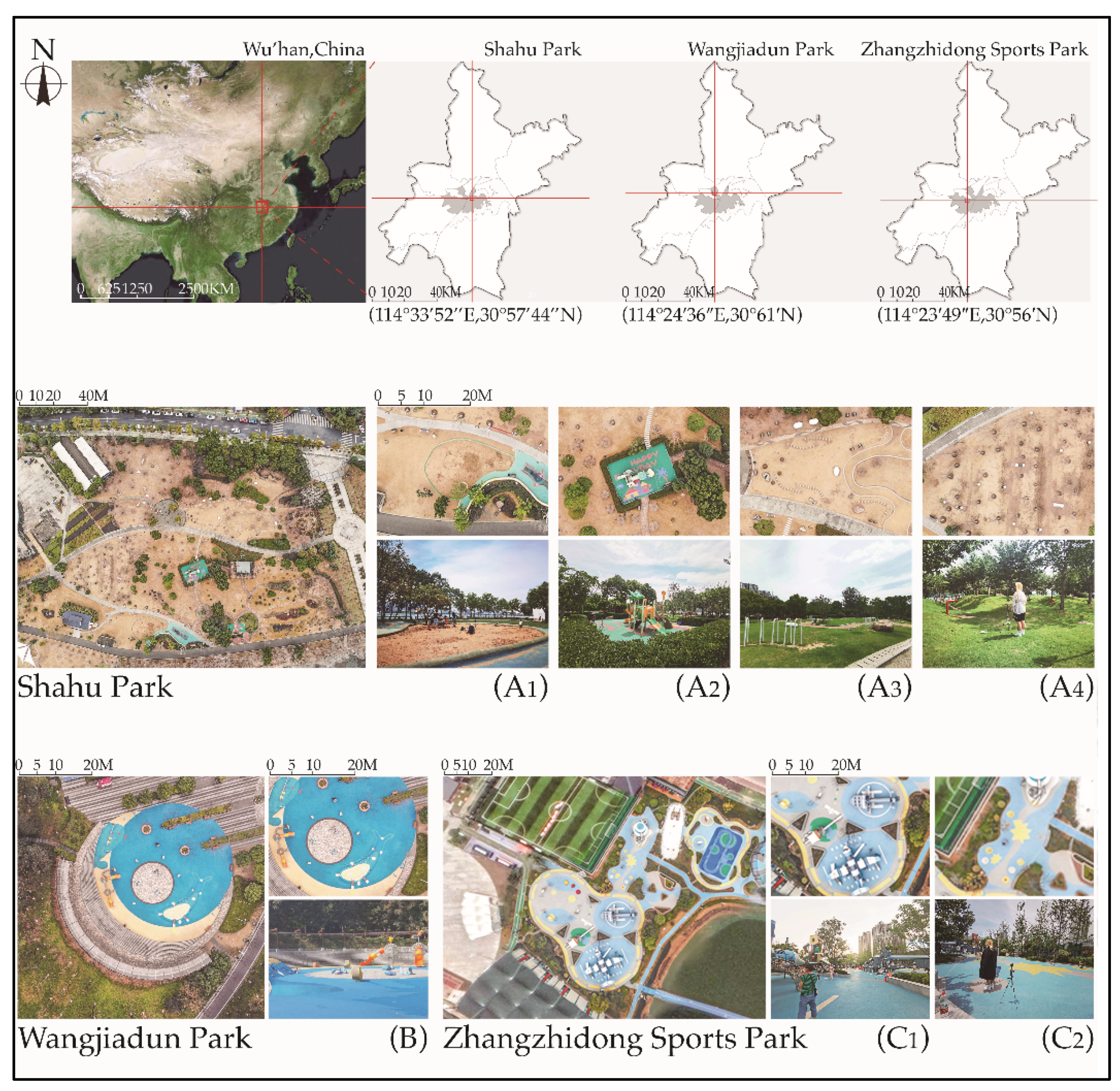
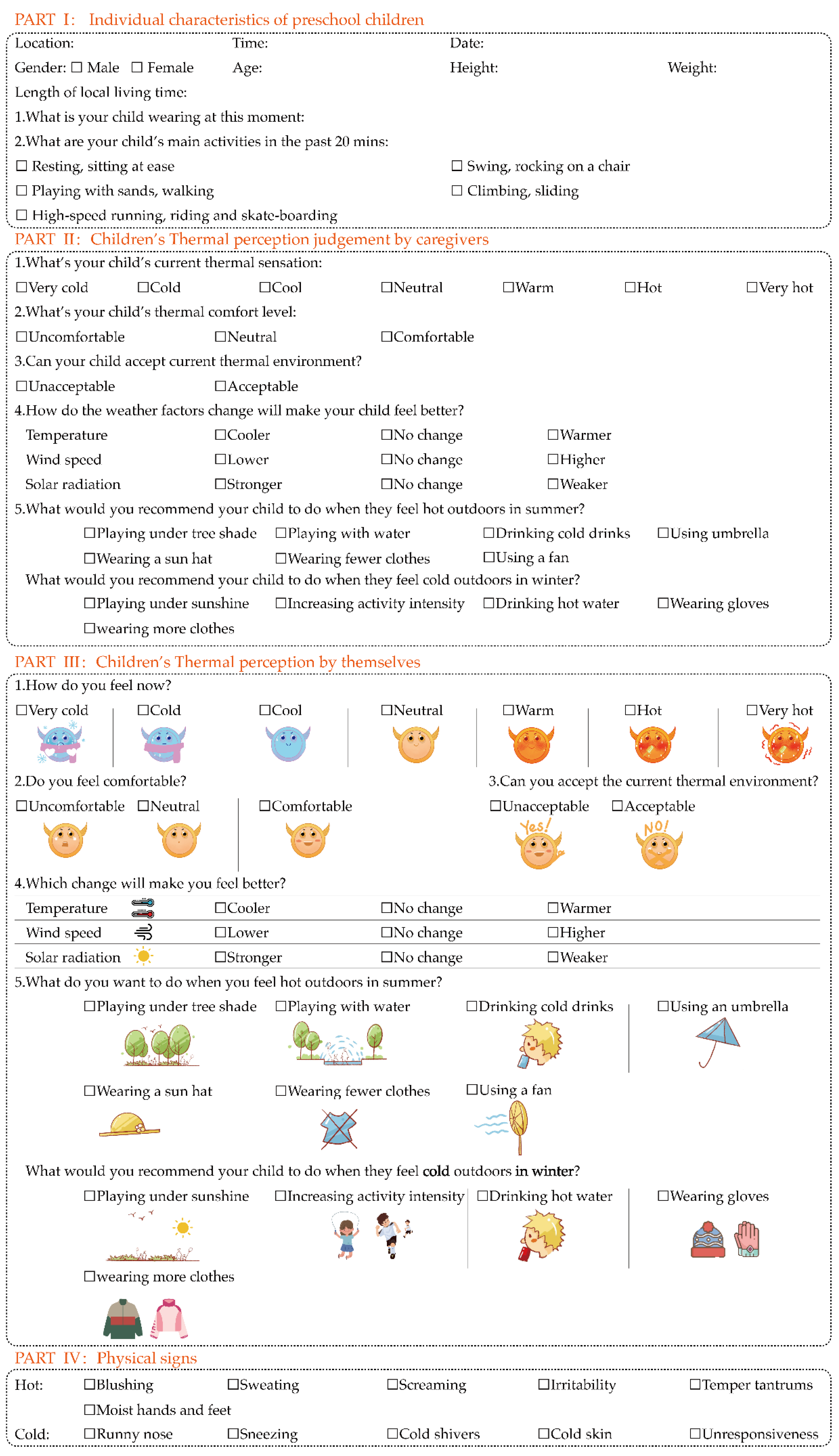
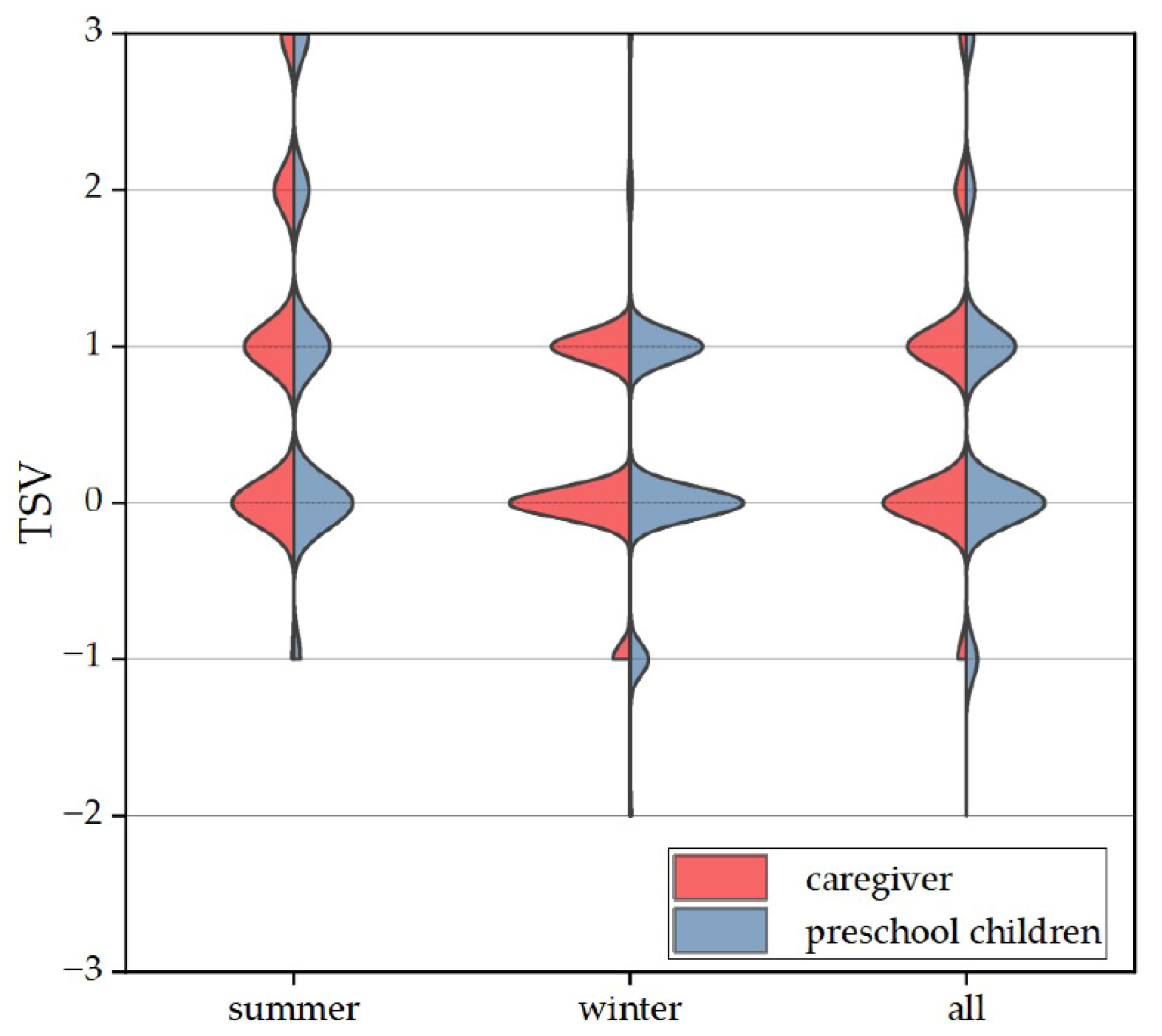
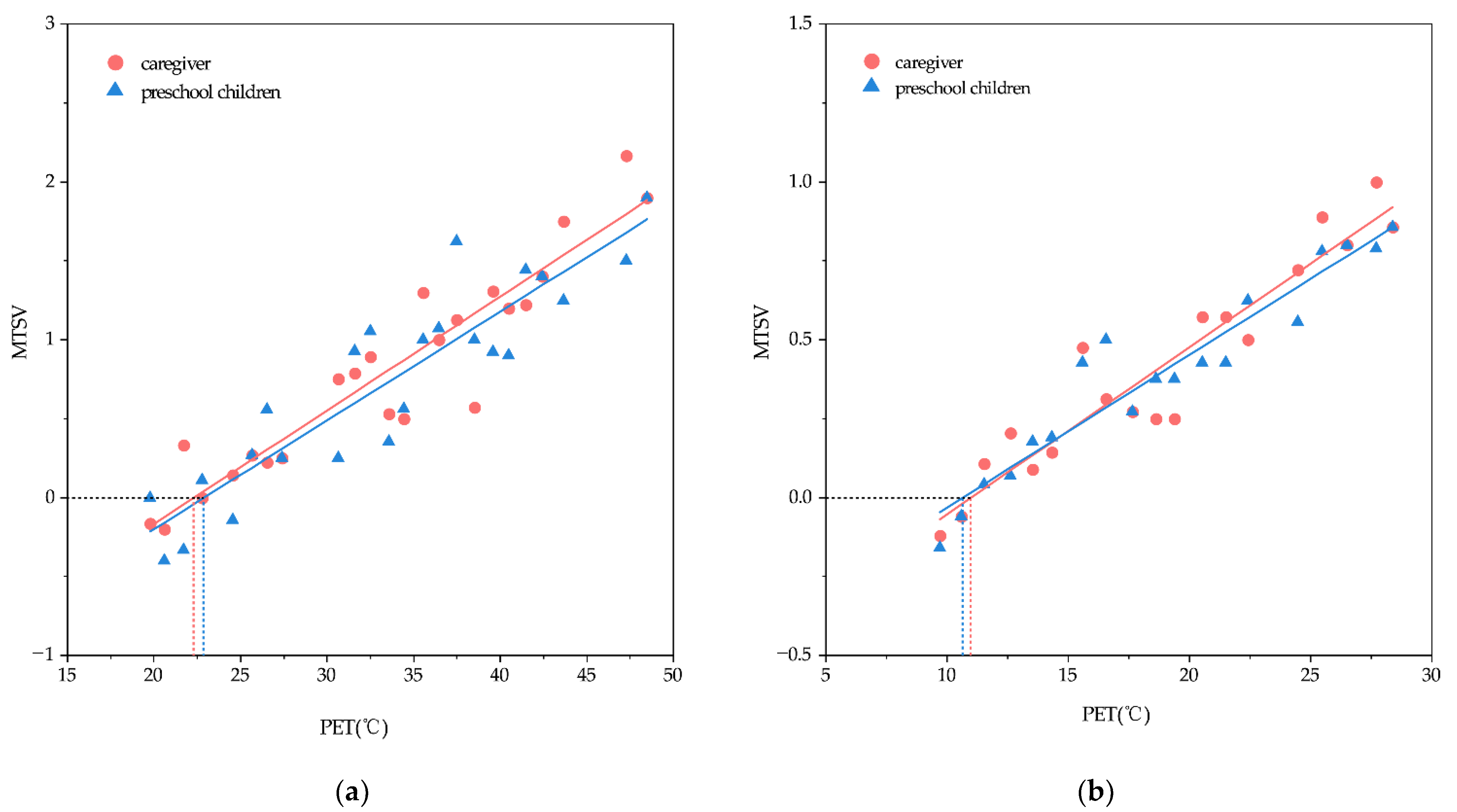
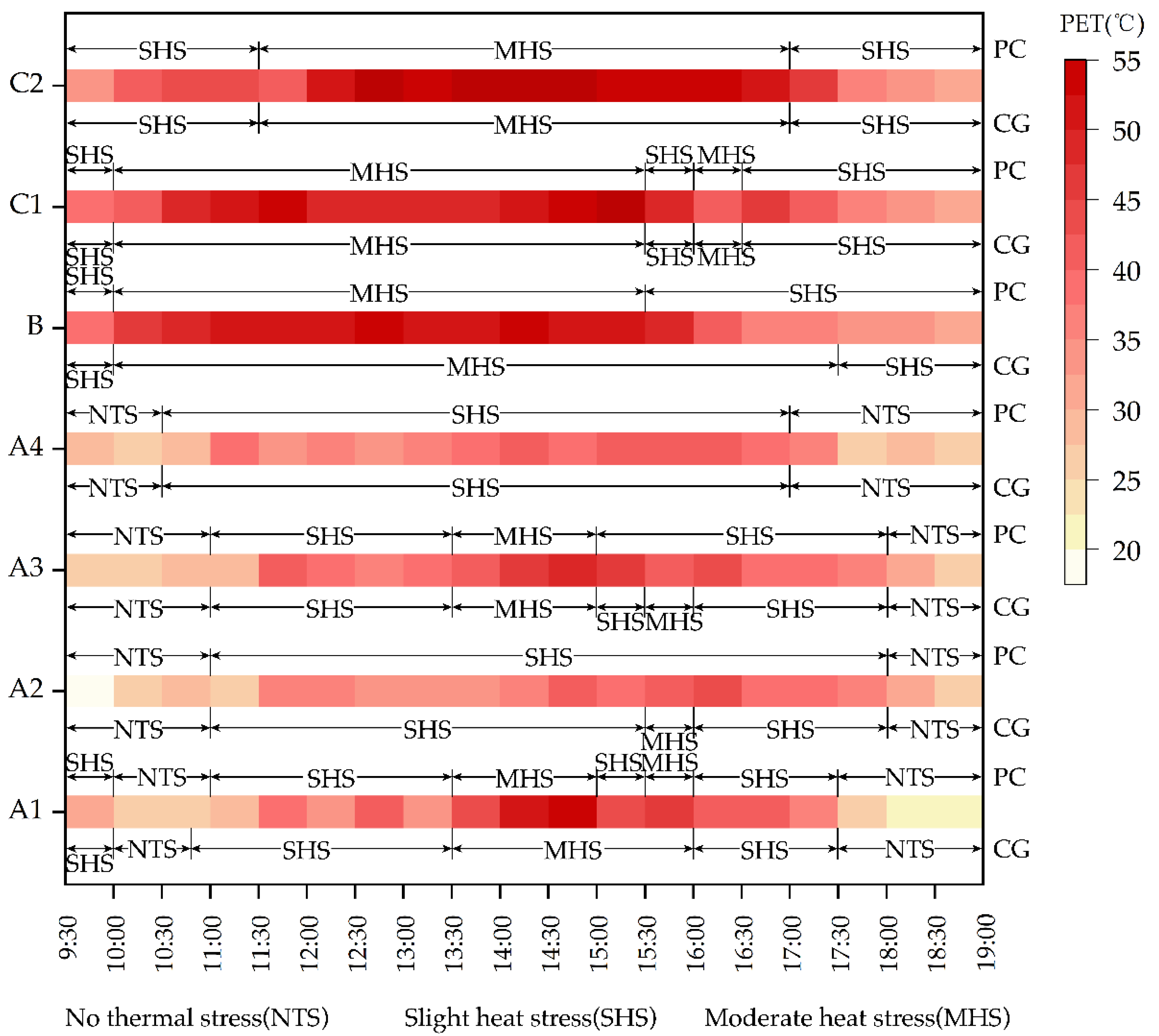
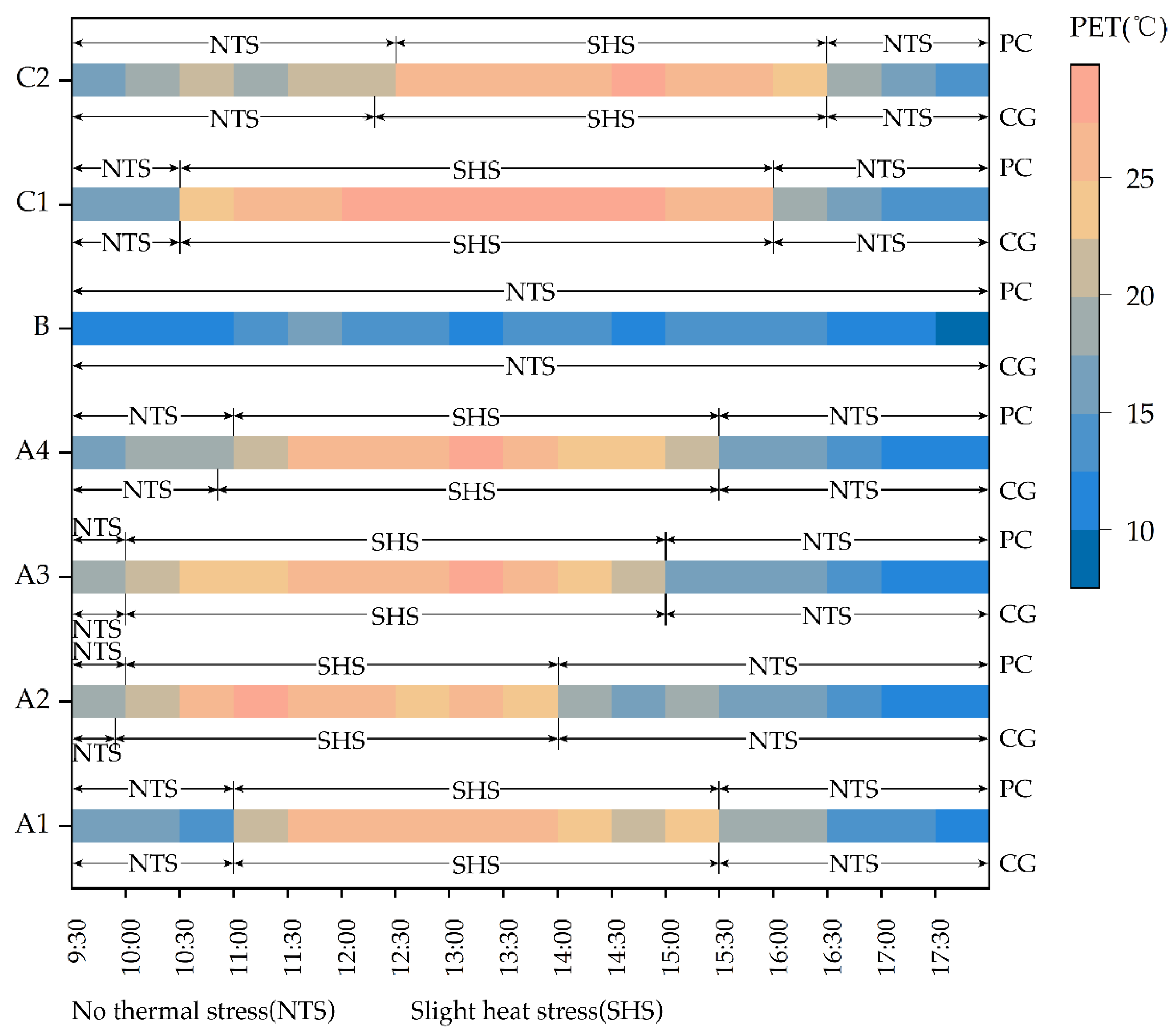
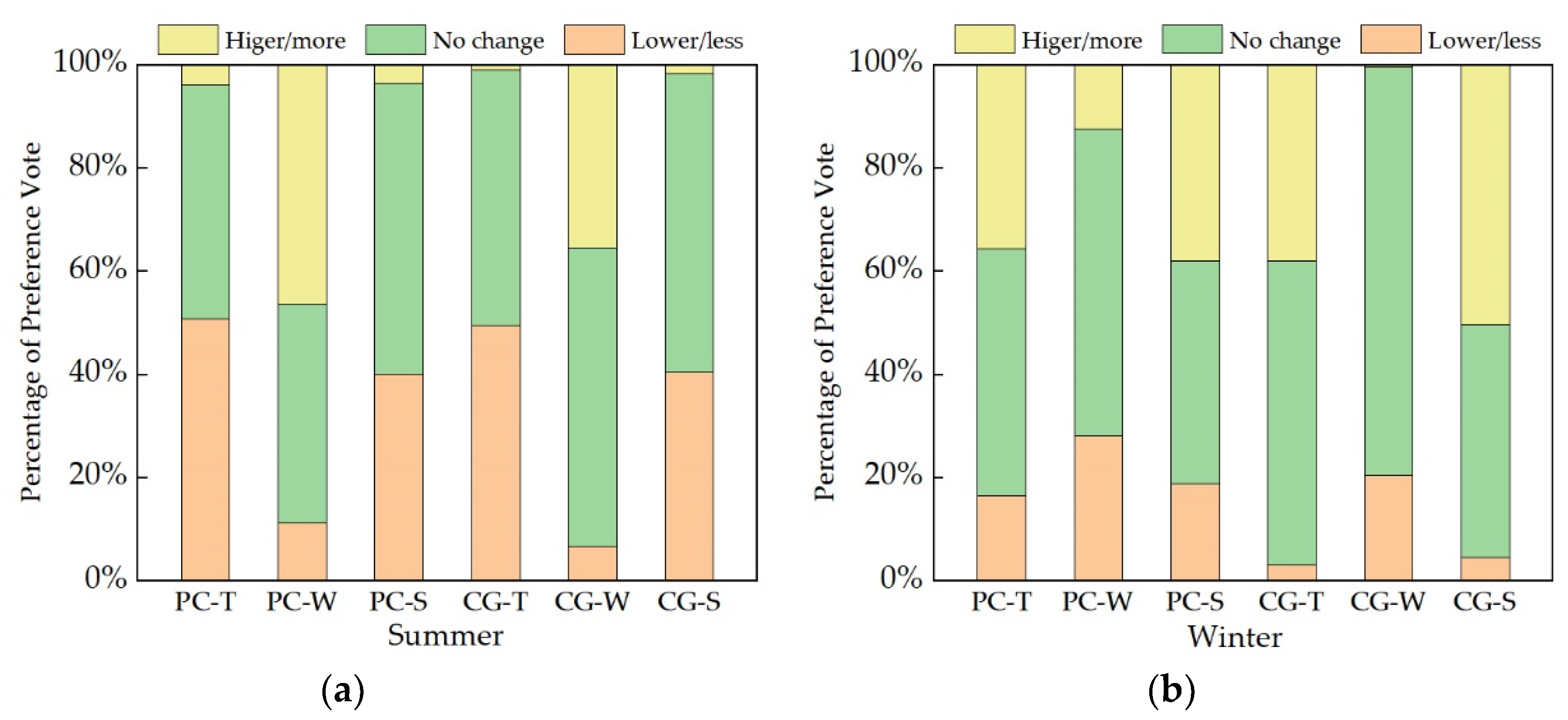
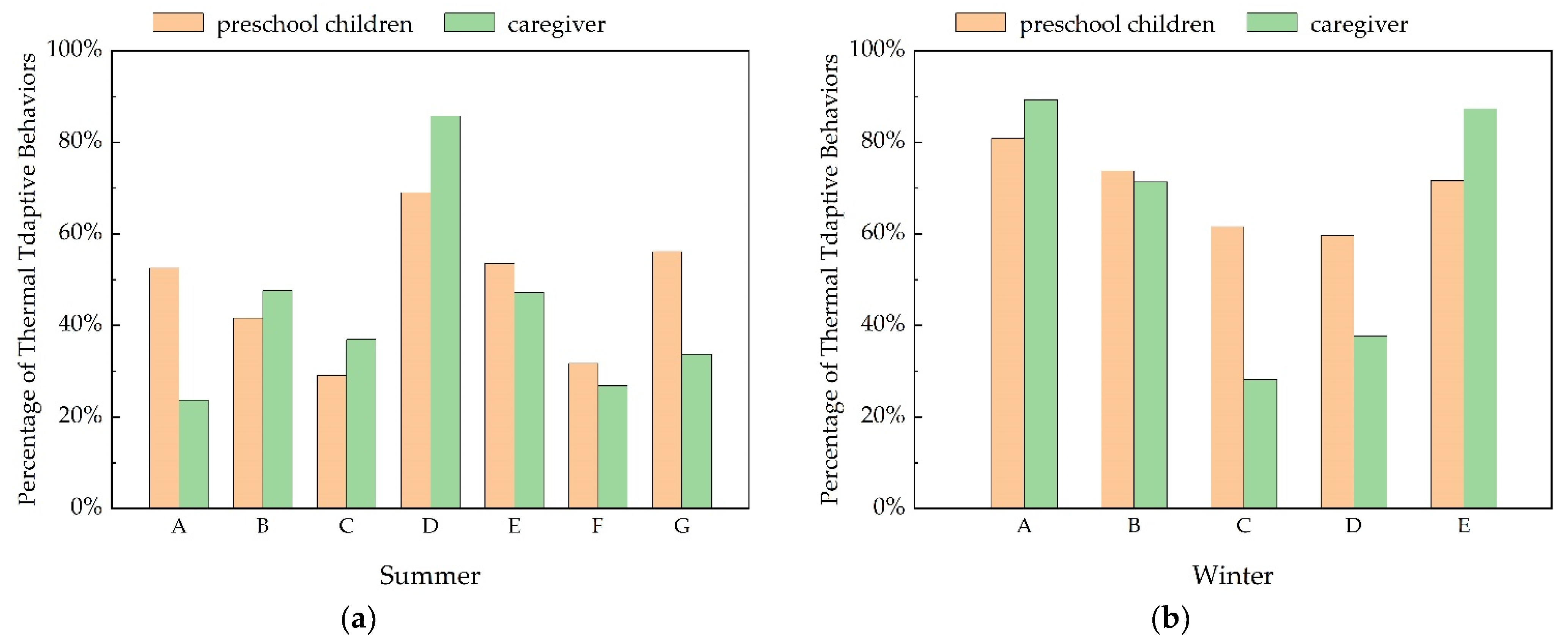
| Park | Site No. | Site Characteristics | Survey Date |
|---|---|---|---|
| Shahu Park | A1 | Close to water bodies, sandy underlying surface, little vegetation, low arbor coverage. | 20 September 2021 2 January 2022 15 January 2022 |
| A2 | Site with event facilities and enclosed by bushes. | ||
| A3 | Meadow as underlying surface, open site with no trees and shrubs. | ||
| A4 | Natural grass slope planted with deciduous trees. | ||
| Wangjiadun Park | B | The southwest side is a hillside, and the monitoring core area is a plastic underlying surface with no vegetation. | 18 September 2021 9 January 2022 |
| Zhangzhidong Sports Park | C1 | Plastic underlying surface, large-scale event facilities, and few deciduous trees. | 12 September 2021 3 January 2022 8 January 2022 |
| C2 | Plastic underlying surface, small-scale event facilities, and few evergreen trees. |
| Instrumentation | Parameter | Range | Accuracy |
|---|---|---|---|
| WSZY-1 | Air temperature | −40–100 °C | ±0.5 °C |
| Relative humidity | 0–100% | ±3% | |
| AZ87786 | Black globe temperature | 0–80 °C | ±1.5 °C |
| UT363 BT | Wind speed | 0–30 m/s | ±(5% + 0.5) m/s |
| Metabolic Rate (W) | ||||||
|---|---|---|---|---|---|---|
| Age | Resting, Sitting | Swing, Rocking on a Chair | Playing with Sands, Walking | Climbing and Sliding | High Speed Running, Riding and Skateboarding | |
| 3 | Male | 40.8 | 48.9 | 77.5 | 138.7 | 159.1 |
| Female | 38.0 | 45.6 | 72.2 | 129.2 | 148.2 | |
| 4 | Male | 43.4 | 52.1 | 82.5 | 147.7 | 169.4 |
| Female | 40.3 | 48.3 | 76.5 | 136.9 | 157.0 | |
| 5 | Male | 46.2 | 55.4 | 87.7 | 156.9 | 180.0 |
| Female | 42.5 | 51.0 | 80.8 | 144.6 | 165.9 | |
| 6 | Male | 48.7 | 58.5 | 92.6 | 165.7 | 190.1 |
| Female | 44.8 | 53.7 | 85.0 | 152.2 | 174.5 | |
| Shahu Park | Wangjiadun Park | Zhangzhidong Sports Park | |
|---|---|---|---|
| Summer | 141 | 80 | 82 |
| Winter | 189 | 65 | 162 |
| Summer | Winter | ||||||||||
|---|---|---|---|---|---|---|---|---|---|---|---|
| Age | Total | Age | Total | ||||||||
| 3 | 4 | 5 | 6 | 3 | 4 | 5 | 6 | ||||
| Numbers | Male | 26 | 37 | 50 | 49 | 162 | 58 | 73 | 60 | 56 | 247 |
| Female | 21 | 24 | 51 | 45 | 141 | 29 | 50 | 55 | 35 | 169 | |
| Mean Value | Height (cm) | 100 | 109 | 113 | 122 | 111 | 100 | 106 | 112 | 122 | 110 |
| Weight (kg) | 16.4 | 17.8 | 19.6 | 24.0 | 19.3 | 16.1 | 17.7 | 19.5 | 23.4 | 19.1 | |
| Clo (clo) | 0.25 | 0.25 | 0.25 | 0.26 | 0.25 | 1.51 | 1.53 | 1.54 | 1.49 | 1.52 | |
| Metabolic rates (W) | 103.4 | 121.5 | 129.2 | 144.1 | 127.9 | 107.0 | 117.18 | 118.9 | 137.4 | 119.9 | |
| Site | Ta (°C) | RH (%) | Tg (°C) | Va (m/s) | Tmrt (°C) | PET (°C) | |
|---|---|---|---|---|---|---|---|
| A1 | Max | 32.6 | 72.3 | 43.2 | 1.70 | 74.4 | 53.8 |
| Mean | 28.7 | 56.3 | 33.8 | 0.98 | 46.1 | 36.0 | |
| Min | 24.6 | 33.5 | 24.9 | 0.30 | 22.4 | 21.7 | |
| A2 | Max | 35.2 | 73.5 | 42.1 | 1.10 | 51.0 | 44.3 |
| Mean | 30.5 | 53.4 | 33.7 | 0.33 | 37.4 | 34.1 | |
| Min | 25.4 | 40.4 | 24.4 | 0.10 | 20.7 | 19.7 | |
| A3 | Max | 33.0 | 75.2 | 44.3 | 0.60 | 63.6 | 49.7 |
| Mean | 28.8 | 55.9 | 34.2 | 0.32 | 42.1 | 35.7 | |
| Min | 24.5 | 44.3 | 23.8 | 0.00 | 23.2 | 24.1 | |
| A4 | Max | 35.1 | 73.9 | 40.3 | 0.50 | 48.7 | 42.4 |
| Mean | 30.5 | 53.3 | 33.7 | 0.26 | 37.6 | 34.5 | |
| Min | 25.2 | 40.8 | 24.6 | 0.00 | 24.1 | 25.3 | |
| B | Max | 42.8 | 50.0 | 50.1 | 0.40 | 60.7 | 53.0 |
| Mean | 37.7 | 33.6 | 42.9 | 0.23 | 48.9 | 45.0 | |
| Min | 31.2 | 25.6 | 30.6 | 0.00 | 30.5 | 32.3 | |
| C1 | Max | 42.8 | 45.6 | 51.2 | 0.80 | 62.9 | 55.8 |
| Mean | 39.1 | 33.4 | 43.6 | 0.39 | 48.9 | 45.7 | |
| Min | 33.1 | 23.0 | 32.2 | 0.10 | 30.6 | 31.6 | |
| C2 | Max | 46.2 | 48.8 | 52.7 | 0.60 | 62.2 | 57.6 |
| Mean | 40.7 | 27.5 | 44.4 | 0.49 | 49.9 | 47.1 | |
| Min | 32.9 | 17.6 | 32.4 | 0.40 | 30.2 | 31.6 | |
| Total | Max | 46.2 | 75.2 | 52.7 | 1.70 | 74.4 | 57.6 |
| Mean | 33.6 | 44.9 | 38.0 | 0.43 | 44.4 | 39.7 | |
| Min | 24.5 | 17.6 | 23.8 | 0.00 | 20.7 | 19.7 |
| Ta (°C) | RH (%) | Tg (°C) | Va (m/s) | Tmrt (°C) | PET (°C) | ||
|---|---|---|---|---|---|---|---|
| A1 | Max | 22.2 | 51.2 | 29.0 | 0.36 | 38.1 | 27.0 |
| Mean | 17.0 | 31.7 | 20.5 | 0.07 | 22.7 | 20.4 | |
| Min | 10.7 | 21.3 | 9.7 | 0.00 | 9.7 | 11.5 | |
| A2 | Max | 25.4 | 43.7 | 27.7 | 0.39 | 31.4 | 27.4 |
| Mean | 18.0 | 29.3 | 19.9 | 0.07 | 21.0 | 20.0 | |
| Min | 10.3 | 19.4 | 9.3 | 0.00 | 9.3 | 11.2 | |
| A3 | Max | 20.7 | 42.9 | 28.3 | 0.33 | 36.1 | 28.1 |
| Mean | 17.1 | 27.3 | 21.4 | 0.09 | 24.4 | 20.7 | |
| Min | 10.3 | 18.0 | 9.3 | 0.00 | 9.3 | 11.2 | |
| A4 | Max | 22.0 | 46.4 | 29.6 | 0.34 | 36.3 | 28.7 |
| Mean | 16.9 | 29.6 | 20.5 | 0.08 | 22.8 | 20.3 | |
| Min | 10.1 | 19.0 | 9.0 | 0.00 | 9.0 | 11.0 | |
| B | Max | 11.7 | 64.5 | 15.2 | 0.11 | 15.2 | 15.1 |
| Mean | 10.2 | 55.9 | 11.7 | 0.02 | 12.1 | 12.4 | |
| Min | 8.4 | 48.8 | 7.9 | 0.00 | 7.9 | 9.9 | |
| C1 | Max | 24.2 | 44.9 | 29.4 | 0.55 | 40.9 | 29.8 |
| Mean | 19.6 | 27.8 | 22.9 | 0.20 | 27.4 | 23.2 | |
| Min | 12.6 | 19.1 | 10.9 | 0.00 | 10.9 | 13.0 | |
| C2 | Max | 24.5 | 44.2 | 28.2 | 0.42 | 36.5 | 27.4 |
| Mean | 19.3 | 28.2 | 21.7 | 0.14 | 24.2 | 21.7 | |
| Min | 12.8 | 18.6 | 11.3 | 0.00 | 11.3 | 13.3 | |
| Total | Max | 25.4 | 64.5 | 29.6 | 0.55 | 40.9 | 29.8 |
| Mean | 16.9 | 32.8 | 19.8 | 0.10 | 22.1 | 19.8 | |
| Min | 8.4 | 18.0 | 7.9 | 0.00 | 7.9 | 9.9 |
| Ta (°C) | RH (%) | Tg (°C) | Va (m/s) | Tmrt (°C) | PET (°C) | ||
|---|---|---|---|---|---|---|---|
| Summer | TSVcg | 0.558 ** | −0.492 ** | 0.505 ** | −0.335 ** | 0.395 ** | 0.512 ** |
| TSVpc | 0.375 ** | −0.328 ** | 0.339 ** | −0.272 ** | 0.264 ** | 0.340 ** | |
| Winter | TSVcg | 0.452 ** | −0.439 ** | 0.434 ** | 0.113 * | 0.413 ** | 0.465 ** |
| TSVpc | 0.421 ** | −0.395 ** | 0.411 ** | 0.069 | 0.379 ** | 0.433 ** |
| Thermal Sensation | Thermal Stress | PET Range (°C) | |||
|---|---|---|---|---|---|
| Summer | Winter | ||||
| Pc | Cg | Pc | Cg | ||
| Neutral | No thermal stress | 15.7–30.2 | 15.4–29.3 | 0.3–21.0 | 1.6–20.5 |
| Warm | Slight heat stress | 30.2–44.7 | 29.3–43.2 | 21.0–41.7 | 20.5–39.3 |
| Hot | Moderate heat stress | 44.7–59.2 | 43.2–57.1 | ||
| City, Country | Climate Zone | Building Climate | Season | Population | NPET (°C) |
|---|---|---|---|---|---|
| Wuhan, China (this study) | Cfa | HSCW | Summer | Preschool children | 22.9 |
| Caregiver | 22.3 | ||||
| Winter | Preschool children | 10.6 | |||
| Caregiver | 11.0 | ||||
| Changsha, China [54] | Cfa | HSCW | Summer | Young adults | 23.3 |
| Chengdu, China [55] | Cwa | HSCW | Summer | Mixed populations | 24.4 |
| Xi’an, China [56] | Cwa/BSk | C | Summer | College students | 20.2 |
| Xi’an, China [29] | Cwa/BSk | C | All Year | Mixed populations | 19.7 |
| Guangzhou, China [57] | Cfa | HSWW | Winter | Mixed populations | 15.6 |
| City, Country | Climate Zone | Building Climate | Season | Population | NPETR (°C) |
|---|---|---|---|---|---|
| Wuhan, China (this study) | Cfa | HSCW | Summer | Preschool children | 15.7–30.2 |
| Caregiver | 15.4–29.3 | ||||
| Winter | Preschool children | 0.3–21.0 | |||
| Caregiver | 1.6–20.5 | ||||
| Changsha, China [58] | Cfa | HSCW | Summer | Mixed populations | 24–31 |
| Xi’an, China [56] | Cwa/BSk | C | Summer | College students | 12.7–27.7 |
| Tianjin, China [59] | Cwa/BSk | C | All Year | Mixed populations | 11–24 |
| Xi’an, China [29] | Cwa/BSk | C | All Year | Mixed populations | 12.4–26.9 |
| Changsha, China [54] | Cfa | HSCW | All Year | Mixed populations | 15–22 |
Publisher’s Note: MDPI stays neutral with regard to jurisdictional claims in published maps and institutional affiliations. |
© 2022 by the authors. Licensee MDPI, Basel, Switzerland. This article is an open access article distributed under the terms and conditions of the Creative Commons Attribution (CC BY) license (https://creativecommons.org/licenses/by/4.0/).
Share and Cite
Qi, J.; Wang, J.; Zhai, W.; Wang, J.; Jin, Z. Are There Differences in Thermal Comfort Perception of Children in Comparison to Their Caregivers’ Judgments? A Study on the Playgrounds of Parks in China’s Hot Summer and Cold Winter Region. Sustainability 2022, 14, 10926. https://doi.org/10.3390/su141710926
Qi J, Wang J, Zhai W, Wang J, Jin Z. Are There Differences in Thermal Comfort Perception of Children in Comparison to Their Caregivers’ Judgments? A Study on the Playgrounds of Parks in China’s Hot Summer and Cold Winter Region. Sustainability. 2022; 14(17):10926. https://doi.org/10.3390/su141710926
Chicago/Turabian StyleQi, Jiaojiao, Jiangping Wang, Wenya Zhai, Jingyong Wang, and Ziliang Jin. 2022. "Are There Differences in Thermal Comfort Perception of Children in Comparison to Their Caregivers’ Judgments? A Study on the Playgrounds of Parks in China’s Hot Summer and Cold Winter Region" Sustainability 14, no. 17: 10926. https://doi.org/10.3390/su141710926
APA StyleQi, J., Wang, J., Zhai, W., Wang, J., & Jin, Z. (2022). Are There Differences in Thermal Comfort Perception of Children in Comparison to Their Caregivers’ Judgments? A Study on the Playgrounds of Parks in China’s Hot Summer and Cold Winter Region. Sustainability, 14(17), 10926. https://doi.org/10.3390/su141710926






